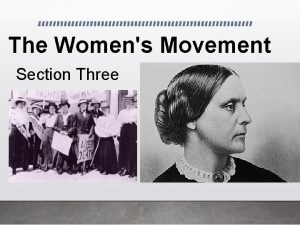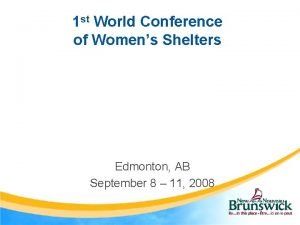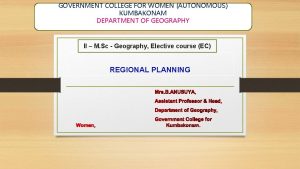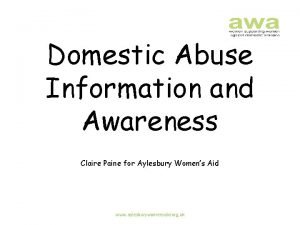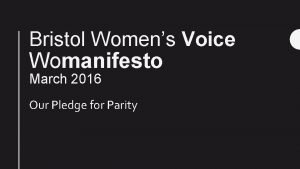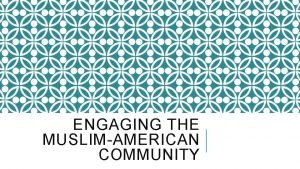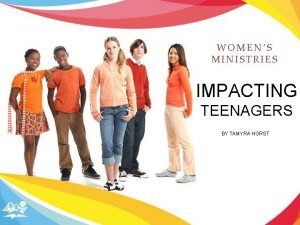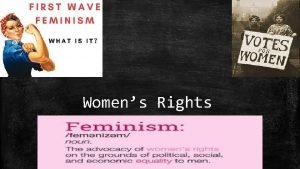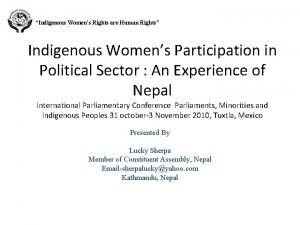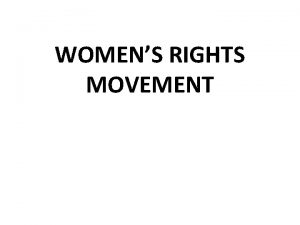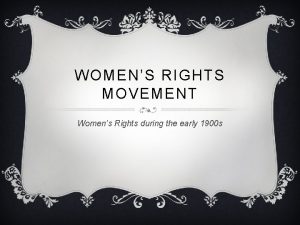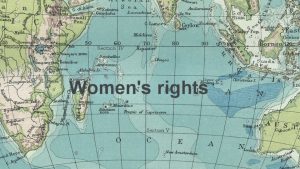En Gende Rights Inc Asserting Womens Rights Advancing















- Slides: 15

En. Gende. Rights, Inc. Asserting Women’s Rights Advancing Women’s ESC Rights Drawing Lessons from the Implementation of Beijing ESCR-Net Side Event New York, NY March 18, 2015 Clara Rita A. Padilla, JD En. Gende. Rights, Inc. (632) 3762578 engenderights@gmail. com

Drawing Lessons from Beijing En. Gende. Rights, Inc. Asserting Women’s Rights l A review of the implementation of the Beijing Declaration & the BPFA shows positive developments in the implementation of the goals and commitments l However, barriers remain in achieving full implementation of the goals set and commitments made in the BPFA and the achievements of the States have been limited or uneven across regions and within countries l We will draw lessons not just from the gains but also from the gaps. Being grounded on the gaps will guide us in finding ways to move forward.

Institutional mechanisms for the advancement of women En. Gende. Rights, Inc. Asserting Women’s Rights l Gains: l Beijing was catalytic in creating and strengthening national machineries. These national machineries played key roles in the development and monitoring of national action plans l Vietnam, Lao PDR and Cambodia: adopted their respective plans of action to promote women's equal participation in economic development l In the Philippines, the national action plan was integrated into the 30 -year national development plan (from Beijing in 1995 -2025) l It included the establishment of police women's desks to deal with VAW cases which desks became part of a 1998 law l Several plans refer to the need to develop tools, methodologies, and indicators

En. Gende. Rights, Inc. Violence against Women Asserting Women’s Rights l Gains: new legislation, policies, action plans and initiatives in many countries to prevent violence against women and girls l Gaps: Unacceptably high rates of all forms of VAW and girls in the region, including sexual, gender-based, intimate-partner and ICT-related violence, among others; l l Persistence of female infanticide, honour crimes, child, early and forced marriage, trafficking in women and girls, beating and killing of women accused of sorcery, dowry-related violence, female genital mutilation and other harmful practices; l Lack of implementation of laws; lack of specific laws on VAW or there are existing discriminatory provisions

En. Gende. Rights, Inc. Violence against Women l l Asserting Women’s Rights Gaps: Lack of implementation of law or there are still lack of specific laws on VAW or there are existing of discriminatory provisions l no divorce law (Phils) l no law on marital rape (Indonesia) or extinguishes crime or penalty upon marriage or forgiveness (Phils) l penalizes trafficking victims for violating immigration laws (Malaysia) l laws allowing polygamy (Indonesia, Malaysia, Phils. ) l No specific law on intimate partner violence (Brunei, Myanmar) or with have discriminatory provisions: l l l allows “preservation of the family” (Cambodia, Singapore); allows “disciplining the wife” (Cambodia); tolerates violence upon “unethical dominance” (Thai); settlement if “not serious” (Lao) criminalizes “prostitution” (Philippines)

En. Gende. Rights, Inc. Violence against Women l l l Asserting Women’s Rights Gaps: As regards the commitment of Member States to establish national action plans to eliminate VAW under CEDAW and Beijing, only a few countries in the Asian region established such national action plans. l Cambodia was the first country to include targets on domestic violence and trafficking in its National MDG Plan 2005. Lack of access of rape victims to emergency contraception and there are no exceptions allowing abortion even in cases of rape (e. g. , Phils. ) Women and Environment l Reality: Asia is prone to disaster l Need: address the impact on women and girls of climate change and disasters, including protecting them from abuse, exploitation and displacement; spike in VAW after a disaster

En. Gende. Rights, Inc. Women and the economy Asserting Women’s Rights l Gains: introduction and strengthening of legislation addressing equal pay for work of equal or comparable value, maternity entitlements l efforts have been made across the region to strengthen the legal and policy frameworks that protect migrant women workers and their families and women workers in the informal economy l Gap: Undocumented migrant women remain vulnerable to exploitation and abuse

Women and the economy En. Gende. Rights, Inc. Asserting Women’s Rights Gaps: l Women continue to bear the primary responsibility for unpaid work, particularly domestic and caregiving work, and comprise the majority of temporary, low-paid and informal workers in the region, often working without any form of social and legal protection. l l l the economic participation of women has remained between 62 and 65 percent of male employment since the early 1990 s. Need: We need to prioritize universal social protection policies enduring gender pay gap, vertical and horizontal segregation of work

Women and Health En. Gende. Rights, Inc. Asserting Women’s Rights l Gains: substantial reduction in the maternal mortality ratio in Asia, which has declined by almost 62 per cent in the last two decades l Gaps: l there is limited access to skilled birth attendants, prenatal & postnatal care, contraceptive services and information, and emergency obstetric and newborn care l overall incidence of maternal mortality in the region remains high including among adolescents l high under-5 mortality at 39 deaths/1000 live births in 2014 l inadequate management of complications arising from unsafe abortion that contribute to a significant proportion of maternal deaths l high adolescent fertility rates (reflective of young age at marriage or union)

Women and Health En. Gende. Rights, Inc. Asserting Women’s Rights l Gaps: l Examples of the impact of lack of access to reproductive health and information: l Manila City: many poor women have 8 -10 children, with childbirths that were not facility-based or were unattended by skilled birth attendants; many did not have prenatal check-ups and were not aware of contraceptive methods l many women have been denied access to post-abortion care and were threatened with criminal prosecution l in cases of induced abortion l also in cases of fetal death, spontaneous abortion and abortion due to trauma from intimate partner violence

Women and Health En. Gende. Rights, Inc. Asserting Women’s Rights NEEDs: lgreater access to comprehensive sexual and reproductive health information and services laccess to age-appropriate sexuality education lrepeal of laws that punish women and girls who have undergone abortions lto end child, early and forced marriage and unwanted pregnancies lneed to halt the rise in new HIV infections among women and girls

En. Gende. Rights, Inc. Asserting Women’s Rights Women and Poverty l l Gaps: poverty among women and girls persists facing multiple forms of discrimination (i. e. , migrant women, indigenous women, women and girls with disabilities, widowed women and female-headed households, single women, divorced women, internally displaced women and girls and older women); l there is an increase in the absolute number of individual women and girls living in hardship and surviving on $1. 25 -$2. 00 per day l women are excluded from ownership and management of land other assets and denied access to economic resources

Education and Training of Women En. Gende. Rights, Inc. Asserting Women’s Rights l Gaps: l Women are more likely to be illiterate and are less likely than men to continue their formal educational l girls are more likely to be out of school at the secondary level as opposed to boys l discriminatory gender stereotypes persist in teaching curricula, among teachers, and in textbooks

Women and girls would benefit from the implementation of the BPFA: l l l l l En. Gende. Rights, Inc. Asserting Women’s Rights expanded indicators addressing the gaps and disaggregated data based on multiple forms of discrimination (Sustainable Dev’t Goals; 17 goals up to 2030) clear targets with timelines in the national action plans resource mobilization governments to champion the equality and empowerment of women from the national to the local levels pro-active national machineries strengthening of gender focal points regular intra-government meetings including the NHRIs and embedded NGO representatives annual submission of national reviews by the States to the regional commissions, UN Women, and CSW discussing good practices, overcoming challenges, and new challenges mainstream gender in all fields

En. Gende. Rights, Inc. Asserting Women’s Rights Thank you! Clara Rita A. Padilla, J. D. Executive Director En. Gende. Rights, Inc.
 Womens rights
Womens rights Womens rights
Womens rights Womens shelter edmonton
Womens shelter edmonton Late night womens hour
Late night womens hour Harijah sivakumar
Harijah sivakumar Ballybeen womens centre
Ballybeen womens centre Womens college kumbakonam
Womens college kumbakonam What is fgm
What is fgm Womens aid aylesbury
Womens aid aylesbury Womens lacrosse helmets
Womens lacrosse helmets Womens college kumbakonam
Womens college kumbakonam Womens history month door
Womens history month door Womens right
Womens right Bristol womens voice
Bristol womens voice Womens right
Womens right Needs of adolescence
Needs of adolescence
